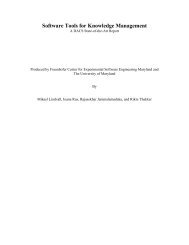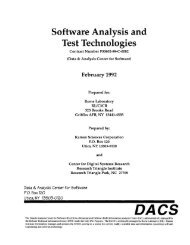Modern Empirical Cost and Schedule Estimation Tools
Modern Empirical Cost and Schedule Estimation Tools
Modern Empirical Cost and Schedule Estimation Tools
You also want an ePaper? Increase the reach of your titles
YUMPU automatically turns print PDFs into web optimized ePapers that Google loves.
Cocomo 2.0<br />
Cocomo 2.0 has recently emerged because of the inability of the original Cocomo (Cocomo 1.1) to<br />
accurately estimate object oriented software, software created via spiral or evolutionary models, <strong>and</strong><br />
software developed from commercial-off-the-shelf software. Several fundamental differences exist<br />
between Cocomo 1.1 <strong>and</strong> 2.0:<br />
• Whereas Cocomo 1.1 requires software size in KSLOC as an input, Cocomo 2.0 provides different<br />
effort estimating models based on the stage of development of the project. An objective of 2.0 is to<br />
require as inputs to the model only the level of information that is available to the user at that time.<br />
As a result, during the earliest conceptual stages of a project, called Application Composition, the<br />
model uses Object Point estimates to compute effort. Object Points are a measure of software<br />
system size, similar to Function Points. During the Early Design stages, when little is known<br />
about project size or project staff, Unadjusted Function Points are used as an input to the model.<br />
Once an architecture has been selected, design <strong>and</strong> development are ready to begin. This is called<br />
the Post Architecture stage. At this point, Source Lines Of Code are inputs to the model.<br />
• Whereas Cocomo 1.1 provided point estimates of effort <strong>and</strong> schedule, Cocomo 2.0 provides likely<br />
ranges of estimates that represent one st<strong>and</strong>ard deviation around the most likely estimate. (Only the<br />
most likely estimates are shown in Tables 1 <strong>and</strong> 2.)<br />
• Cocomo 2.0 adjusts for software reuse <strong>and</strong> reengineering where automated tools are used for<br />
translation of existing software. Cocomo 1.1 made little accommodation for these factors<br />
• Cocomo 2.0 also accounts for requirements volatility in its estimates.<br />
• The exponent on size in the effort equations in Cocomo 1.1 varies with the development mode.<br />
Cocomo 2.0 uses five scale factors to generalize <strong>and</strong> replace the effects of the development mode.<br />
The Cocomo 2.0 Application Composition model (as shown on the third row of Table 1 ) uses Object<br />
Points to perform estimates. The model assumes the use of Integrated CASE tools for rapid prototyping.<br />
Objects include screens, reports <strong>and</strong> modules in third generation programming languages. Object Points<br />
are not necessarily related to objects in Object Oriented Programming. The number of raw objects are<br />
estimated, the complexity of each object is estimated, <strong>and</strong> the weighted total (Object-Point count) is<br />
computed. The percentage of reuse <strong>and</strong> anticipated productivity are also estimated. With this information,<br />
the effort estimate shown in Table 1 can be computed.<br />
Function Points are a very popular method of estimating the size of a system, especially early in the life<br />
cycle of a product. Function Points are arguably easier to estimate than KSLOC early in the life cycle.<br />
Function Points form the size input for the Cocomo 2.0 Early Design model, shown in the fourth row of<br />
Table 1. Function Points measure the amount of functionality in a software product based on five<br />
characteristics of the product: the number of external inputs, the number of external outputs, the number<br />
of internal logical files, the number of external interface files, <strong>and</strong> the number of external inquiries into<br />
the product. Each instance is then weighted by a complexity factor of low, average or high to compute an<br />
Unadjusted Function Point (UFP) of:<br />
5 3<br />
UFP = Σ Σ W Z<br />
i =1 j =1 ij ij<br />
where Z ij is the count for component i at complexity j <strong>and</strong> W ij is the fixed weight assigned. Unadjusted<br />
Function Points are converted to equivalent source lines of code (SLOC) by using Table 3 on the next page.<br />
<strong>Modern</strong> <strong>Empirical</strong> <strong>Cost</strong> <strong>and</strong> <strong>Schedule</strong> <strong>Estimation</strong> <strong>Tools</strong><br />
10




